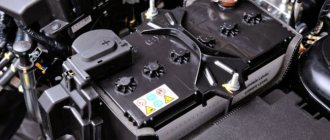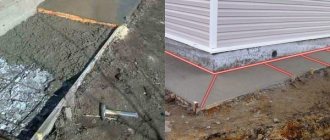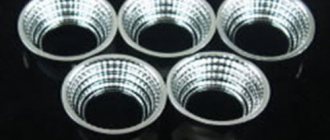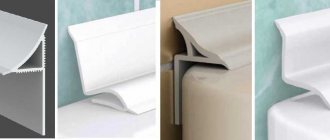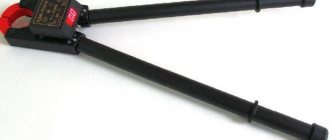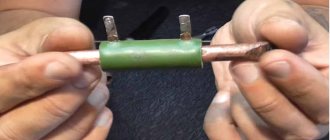It's no secret that each of us as a child wanted to have a device like a laser machine that could cut metal seals and burn through walls. In the modern world, this dream can easily come true, since it is now possible to build a laser with the ability to cut various materials.
Electrical circuit of the laser diode power supply.
Of course, at home it is impossible to make a laser machine so powerful that it will cut through iron or wood. But with a homemade device you can cut paper, polyethylene sealing or thin plastic.
Using a laser device, you can burn various patterns on sheets of plywood or wood. It can be used to illuminate objects located in remote areas. The scope of its application can be both entertaining and useful in construction and installation work, not to mention the realization of creative potential in the field of engraving on wood or plexiglass.
Cutting laser
Tools and accessories you will need to make your own laser:
Figure 1. Laser LED circuit diagram.
- faulty DVD-RW drive with a working laser diode;
- laser pointer or portable collimator;
- soldering iron and small wires;
- 1 Ohm resistor (2 pcs.);
- capacitors 0.1 µF and 100 µF;
- AAA batteries (3 pcs.);
- small tools such as a screwdriver, knife and file.
These materials will be quite sufficient for the upcoming work.
So, for a laser device, first of all, you need to select a DVD-RW drive with a mechanical breakdown, since the optical diodes must be in good condition. If you do not have a worn-out drive, you will have to purchase it from people who sell it for spare parts.
When purchasing, keep in mind that most drives from the manufacturer Samsung are unsuitable for the manufacture of cutting lasers. The fact is that this company produces DVD drives with diodes that are not protected from external influences. The lack of a special housing means that the laser diode is subject to thermal stress and contamination. It can be damaged with a light touch of your hand.
Figure 2. Laser from a DVD-RW drive.
The best option for a laser would be a drive from the manufacturer LG. Each model is equipped with a crystal with varying degrees of power. This indicator is determined by the writing speed of dual-layer DVDs. It is extremely important that the drive is a recording drive, since it contains an infrared emitter, which is needed to make a laser. A regular one will not work, since it is intended only for reading information.
DVD-RW with a 16X recording speed is equipped with a red crystal with a power of 180-200 mW. The 20X speed drive contains a 250-270 mW diode. High-speed recording devices of the 22X type are equipped with laser optics, the power of which reaches 300 mW.
Disassembling the DVD-RW drive
This process must be done with great care, since the internal parts are fragile and can be easily damaged. Having dismantled the case, you will immediately notice the necessary part; it looks like a small piece of glass located inside the mobile carriage. Its base needs to be removed; it is shown in Fig. 1. This element contains an optical lens and two diodes.
At this stage, you should immediately warn that the laser beam is extremely dangerous to human vision.
If it hits the lens directly, it damages the nerve endings and the person may remain blind.
The laser beam is blinding even at a distance of 100 m, so it is important to watch where you point it. Remember that you are responsible for the health of others while such a device is in your hands!
Figure 3. LM-317 chip.
Before you begin, you need to know that the laser diode can be damaged not only by careless handling, but also by voltage surges. This can happen in a matter of seconds, which is why diodes operate based on a constant source of electricity. When the voltage increases, the LED in the device exceeds its brightness standard, as a result of which the resonator is destroyed. Thus, the diode loses its ability to heat, it becomes an ordinary flashlight.
The crystal is also affected by the temperature around it; as it drops, the laser performance increases at a constant voltage. If it exceeds the standard norm, the resonator is destroyed according to a similar principle. Less commonly, the diode is damaged by sudden changes, which are caused by frequent switching on and off of the device over a short period.
After removing the crystal, you must immediately tie up its ends with exposed wires. This is necessary to create a connection between its voltage outputs. To these outputs you need to solder a small capacitor of 0.1 µF with negative polarity and 100 µF with positive polarity. After this procedure, you can remove the wound wires. This will help protect the laser diode from transients and static electricity.
Nutrition
Dependence of the absorbed energy of laser radiation on the radius of the beam and the type of connection.
Before creating a battery for the diode, it is necessary to take into account that it must be powered from 3V and consumes up to 200-400 mA, depending on the speed of the recording device. You should avoid connecting the crystal directly to batteries as this is not a simple lamp. It can deteriorate even under the influence of ordinary batteries. The laser diode is a self-contained element that is supplied with electricity through a regulating resistor.
The power supply system can be configured in three ways with varying degrees of complexity. Each of them requires recharge from a constant voltage source (batteries).
The first method involves electrical regulation using a resistor. The internal resistance of a device is measured by detecting the voltage as it passes through the diode. For drives with a 16X write speed, 200 mA will be sufficient. If this indicator increases, there is a possibility of damaging the crystal, so you should stick to the maximum value of 300 mA. It is recommended to use a telephone battery or AAA batteries as a power source.
The advantages of this power supply are simplicity and reliability. Among the disadvantages are the discomfort when regularly recharging the battery from the phone and the difficulty of placing batteries in the device. In addition, it is difficult to determine the right moment to recharge the power source.
Figure 4. LM-2621 chip.
If you use three AA batteries, this circuit can be easily installed in a Chinese-made laser pointer. The finished design is shown in Fig. 2, two 1 Ohm resistors in sequence and two capacitors.
For the second method, the LM-317 chip is used. This method of arranging a power system is much more complicated than the previous one; it is more suitable for stationary type laser installations. The scheme is based on the manufacture of a special driver, which is a small board. It is designed to limit the electric current and create the necessary power.
The connection circuit of the LM-317 microcircuit is shown in Fig. 3. It will require elements such as a 100 ohm variable resistor, 2 10 ohm resistors, a 1H4001 series diode and a 100 μF capacitor.
A driver based on this circuit maintains electrical power (7V) regardless of the power source and ambient temperature. Despite the complexity of the device, this circuit is considered the simplest for assembly at home.
The third method is the most portable, making it the most preferred of all. It provides power from two AAA batteries, maintaining a constant voltage level supplied to the laser diode. The system maintains power even when the battery level is low.
When the battery is completely discharged, the circuit will stop functioning, and a small voltage will pass through the diode, which will be characterized by a weak glow of the laser beam. This type of power supply is the most economical, its efficiency factor is 90%.
Diagram of a two-standard optical head.
To implement such a power system, you will need an LM-2621 microcircuit, which is housed in a 3x3 mm package. Therefore, you may encounter certain difficulties during the period of soldering parts. The final size of the board depends on your skills and dexterity, since the parts can be placed even on a 2x2 cm board. The finished board is shown in Fig. 4.
The choke can be taken from a regular power supply for a desktop computer. A wire with a cross-section of 0.5 mm is wound onto it with a number of turns of up to 15 turns, as shown in the figure. The throttle diameter from the inside will be 2.5 mm.
Any Schottky diode with a value of 3 A is suitable for the board. For example, 1N5821, SB360, SR360 and MBRS340T3. The power supplied to the diode is adjusted by a resistor. During the setup process, it is recommended to connect it to a 100 Ohm variable resistor. When testing functionality, it is best to use a worn or unwanted laser diode. The current power indicator remains the same as in the previous diagram.
Once you find the most suitable method, you can upgrade it if you have the necessary skills to do so. The laser diode must be placed on a miniature heatsink so that it does not overheat when the voltage increases. After completing the assembly of the power system, you need to take care of installing the optical glass.
Assembly Tips
To check the operation of the driver, use a multimeter to measure the current supplied to the diode. To do this, connect a non-working (or second) diode to the device. For most homemade devices, a current of 300-350 mA is sufficient.
If you need a more powerful laser, the indicator can be increased, but not more than 500 mA.
It is better to use an LED flashlight as a homemade housing. It is compact and convenient to use. To prevent the lenses from getting dirty, the device is stored in a special case.
Important! A laser cutter is a kind of weapon, so it should not be pointed at people, animals, or given to children. Carrying it in your pocket is not recommended.
It should be noted that do-it-yourself laser cutting of thick workpieces is impossible, but it can cope with everyday tasks.
Optics placement
To create a collimator, it is recommended to remove the optical lens from the Chinese laser pointer. In this case, the beam will have a diameter of at least 5 mm, which is too high. The stock collimator lens reduces the beam diameter to 1 mm, but you will have to work hard to tune such a laser. This is due to the small focal length, which makes it difficult to regulate the beam width.
If you do manage to set up the stock optics, the laser can easily cut through plastic bags and pop balloons in no time. When pointed at a wood surface, the beam will burn through it like a soldering iron. The main thing is not to forget about safety precautions when using.
The principle and mechanism of operation of a laser epilator
Operating principle: a laser light pulse affects melanin (coloring pigment), which, in turn, absorbs thermal energy that destroys the follicle. In this case, hair removal occurs due to strong heating of the hair follicle.
The laser hair removal technology of other devices operating at longer wavelengths is somewhat different. Penetrating into the skin up to 4 mm, the laser beam destroys not only the hair follicle, but also affects the vessel that feeds it.
The safety of the laser procedure is due to the fact that any effect on the hair does not affect the skin that is being treated.
The action of laser hair removal is aimed at melanin, this is how it happens:
- melanin is a pigment that gives color to our eyes, hair and skin;
- when a laser pulse acts on melanin, heating it, the skin receives only residual heat, since there is not enough melanin in the epidermis for strong heating;
- Since the skin is not susceptible to strong heat, there will be no burn on the skin.
To minimize possible irritation, since the skin is still being treated, a special gel or cream is applied to the skin before and after the procedure.

